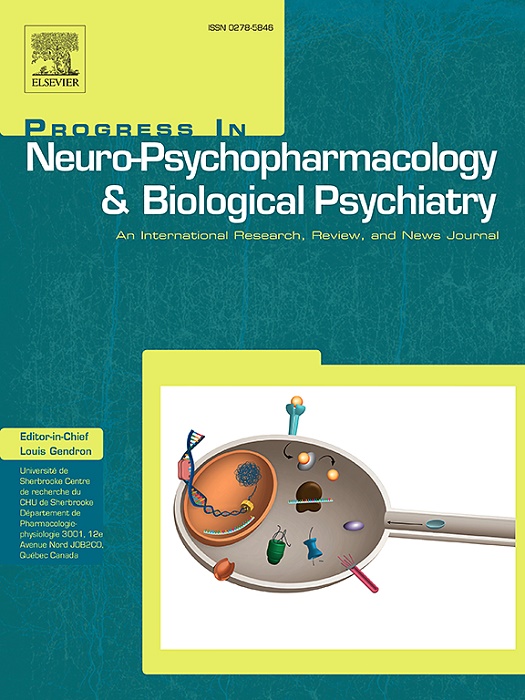Tph2缺乏导致新生大鼠社会适应和社会情感交流的改变:公共筑巢无拯救作用。
IF 3.9
2区 医学
Q1 CLINICAL NEUROLOGY
Progress in Neuro-Psychopharmacology & Biological Psychiatry
Pub Date : 2025-08-12
DOI:10.1016/j.pnpbp.2025.111469
引用次数: 0
摘要
色氨酸羟化酶2 (TPH2)是大脑中5-羟色胺(5-羟色胺,5-HT)合成的限速酶,其缺乏会导致跨物种(包括小鼠、大鼠和猴子)的社会情感交流和母系关系受损。我们最近在Tph2基因敲除大鼠模型中应用了一种拯救方案,并证明了共同筑巢可以改善母系联系障碍。然而,有趣的是,这种拯救策略并没有导致社会情感交流的改善,而且与tph2缺陷后代的生长迟缓表型加重有关。在本研究中,我们旨在更深入地了解社会情感沟通、筑巢条件和测试环境之间的相互作用。为此,我们研究了Tph2-/-敲除、Tph2+/-杂合和Tph2+/+野生型两种性别的大鼠幼崽,随机分配到标准和公共筑巢中。我们进行了详细的光谱分析,并比较了在社会测试条件下,即母亲偏好测试和归巢测试,与非社会测试条件下,即隔离箱测试,隔离诱导的超声波发声的发射。我们的研究结果表明,Tph2缺乏导致隔离诱导的超声波呼叫发生显著变化,这与母体反应性降低有关,包括声学特征的变化,例如呼叫持续时间增加,但频率调制减少。值得注意的是,无论是否共同筑巢,Tph2-/-幼崽通常没有表现出社会适应的证据,甚至与Tph2+/+幼崽相反,这表明它们在适当适应社会环境变化的能力和/或动机方面有所降低或延迟。这种社会适应的改变可能会通过降低母婴互动的质量而导致生长迟缓。本文章由计算机程序翻译,如有差异,请以英文原文为准。
Tph2 deficiency leads to alterations in social adjustment and socio-affective communication in neonatal rats: No rescue effect of communal nesting
Deficiency of tryptophan hydroxylase 2 (TPH2), the rate-limiting enzyme for serotonin (5-hydroxytryptamine, 5-HT) synthesis in the brain, was repeatedly reported to cause impairments in socio-affective communication and maternal affiliation across species, including mice, rats, and monkeys. We recently applied a rescue protocol in the Tph2 knockout rat model and demonstrated that communal nesting ameliorates maternal affiliation impairments. Interestingly, however, this rescue strategy did not lead to improvements in socio-affective communication and was associated with an aggravated growth retardation phenotype in Tph2-deficient offspring. In the present study, we aimed to gain deeper insight into the interplay between socio-affective communication, nesting condition, and test context. To this aim, we studied Tph2−/− knockout, Tph2+/− heterozygous, and Tph2+/+ wildtype rat pups of both sexes, randomly assigned to standard versus communal nesting. We performed detailed spectrographic analyses and compared the emission of isolation-induced ultrasonic vocalizations under social test conditions, i.e., the maternal preference test and the homing test, to non-social test conditions, i.e., the isolation box test. Our results show that Tph2 deficiency causes prominent alterations in isolation-induced ultrasonic calling linked to reduced maternal responsiveness, including changes in acoustic features, e.g., increased call duration but reduced frequency modulation. Remarkably, irrespective of communal nesting, Tph2−/− pups typically displayed either no evidence for social adjustment or even changes opposite to Tph2+/+ littermates, suggesting a reduction and/or delay in the capability and/or motivation to appropriately adjust to changes in the social environment. Such alterations in social adjustment likely contribute to growth retardation through reduced quality of mother-pup interactions.
求助全文
通过发布文献求助,成功后即可免费获取论文全文。
去求助
来源期刊
CiteScore
12.00
自引率
1.80%
发文量
153
审稿时长
56 days
期刊介绍:
Progress in Neuro-Psychopharmacology & Biological Psychiatry is an international and multidisciplinary journal which aims to ensure the rapid publication of authoritative reviews and research papers dealing with experimental and clinical aspects of neuro-psychopharmacology and biological psychiatry. Issues of the journal are regularly devoted wholly in or in part to a topical subject.
Progress in Neuro-Psychopharmacology & Biological Psychiatry does not publish work on the actions of biological extracts unless the pharmacological active molecular substrate and/or specific receptor binding properties of the extract compounds are elucidated.

 求助内容:
求助内容: 应助结果提醒方式:
应助结果提醒方式:


